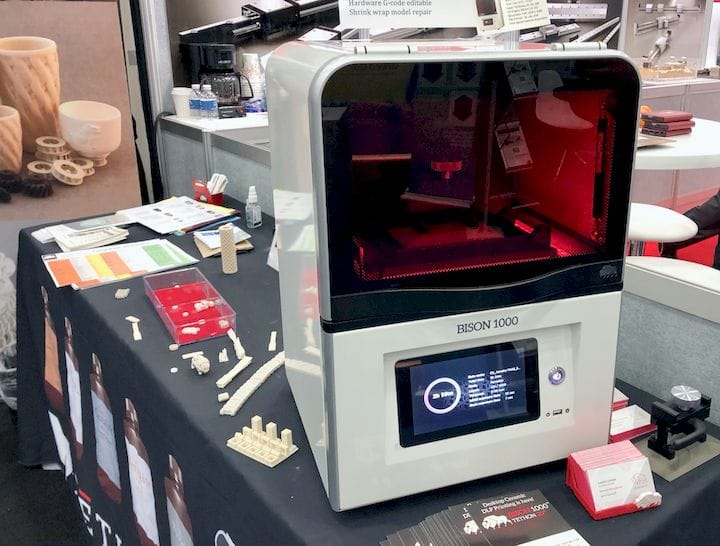![The Bison 1000 3D Printer [Source: Fabbaloo]](https://fabbaloo.com/wp-content/uploads/2020/05/image-asset_img_5eb094b2e9a3c.jpg)
We had a look at Tethon 3D’s upcoming Bison 1000 3D printer.
This is the first 3D printer produced by the Omaha-based company. Previously and through today they continue to sell highly specialized photopolymer resins, particularly those used for ceramic 3D printing. Now they’re branching into hardware directly.
The Bison 1000 is, as you might suspect given the company’s history, a resin-based 3D printer. Rather than using a laser, the machine uses an LED / DLP approach as its light engine. This means it can solidify an entire layer at a time, speeding print operations.
For the build volume, it is small, as is typical for resin-based 3D printers at 110 x 60 x 130 mm. The machine can print layers at 0.100, 0.050 or 0.025 mm layers. But the X-Y resolution — or rather the pixel size as it illuminates the liquid photopolymer resin surface — is a tiny 0.057mm. This should enable some very crisp prints.
The Bison 1000 can accept up to one liter of resin at a time, and it can control the heat of the resin throughout the print.
The resin vat, through which the light shines, is said to be “durable”. This refers to the phenomenon where the print must “peel” off the bottom of the resin vat each layer, as the solidification process tends to fuse a bit of the material with the tank itself.
Tethon 3D says the film coating on the resin tank bottom is replaceable and “affordable”, although we don’t yet know the pricing. I’d consider this a consumable item on this machine.
Bison 3D Printer Specifications
The Bison 1000 is enabled for networking through its hardwired ethernet port. I’m not sure if it has a WiFi connection, however. But once connected, the machine can be operated remotely as there is an onboard webcam to view prints live, as well as a smartphone app to operate wherever you happen to be.
What’s very interesting is the digital capacity of the device. The associated custom slicing software, “Tethonware”, can “accept extremely large files”. The device itself has a large 22GB hard disk internal storage system to hold truly gigantic GCODE files.
My suspicion is that these two features are intended to enable the Bison 1000 to successfully 3D print extremely detailed 3D models at high resolution, which would be a tremendous advantage for a small volume resin machine such as this.
Resin 3D Print Parameters
![Control panel on the Bison 1000 3D printer to set up print parameters [Source: Fabbaloo]](https://fabbaloo.com/wp-content/uploads/2020/05/bison-1000-resin-printer-profiles-1_img_5eb094b344c5c.jpg)
We’re told the machine also includes onboard print profiles for Tethon 3D resins, and that they are also updatable remotely by the company to keep them up to date with current print parameter thinking. Interestingly, the profiles are kept on the machine itself, and not just in the slicing software.
While the machine is considered an “open materials” device, it does not by default include profiles for non-Tethon 3D resins. However, the software does allow you to develop them for your own use.
As of today, you cannot buy a Bison 1000 3D printer, but you can reserve one. We’re told the machine should be available later this year, likely in Q3, at a cost “under US$20K”.
Via Tethon 3D











FELIXprinters has released a new bioprinter, the FELIX BIOprinter, which is quite a change for the long-time 3D printer manufacturer.